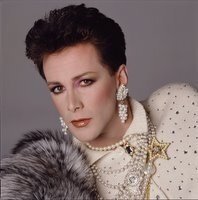A New Sybil's "WHO'Z DAT?"... ERNEST THESIGER (January 15, 1879 - January 14, 1961)
/Darlings! Mummy has made a decision! After reading dozens of posts and having hundreds of conversations with well-meaning folks who just don't know about the great CHARACTER actors who gave films the depth and genius that surrounded and supported the so-called "stars", I am going to post a regular, special entry called SYBIL'S "WHO'Z DAT??"....there'll be photos and a mini-bio, and the next time you see one of those familiar, fabulous faces that you just "can't quite place".......well, maybe these posts will help. Some of these actors worked more, had longer and broader careers, and ended up happier, more loved, and even wealthier than the "stars" that the public "worships"......I think there may be a metaphor in that! What do you think??? And while you’re considering it, let me introduce one of the rarest performers in the history of Hollywood…. An orchid in a field of daisies! He's Ernest Thesiger (January 15, 1879 - January 14, 1961).
The grandson of the 1st Lord Chelmsford, Thesiger was born in London, England and was the first cousin once removed of the explorer and author Wilfred Thesiger (1910–2003), and the nephew of 2nd Lord Chelmsford, who, exactly a week after Ernest's birth, famously led his troops in battle against and suffered a defeat at the hands of a Zulu army at the Battle of Isandlwana.
Thesiger attended Marlborough College and the Slade School of Art with aspirations of becoming a painter, but quickly switched to drama, making his professional debut in a production of Colonel Smith in 1909. After the outbreak of World War I, in 1914 Thesiger volunteered as Rifleman No.2546 with the 2nd Battalion of the 9th London Regiment (Queen Victoria's Rifles). After training in England for 3 months he was sent to the Western Front in late 1914, and was wounded in the trenches on New Year’s Day in 1915. He was medically evacuated back to England. At a dinner party shortly after his return, someone asked him what it had been like in France, to which he is supposed to have responded "Oh, my dear, the noise! …and the people!"
In 1917, he married Janette Mary Fernie Ranken (1877-1970), sister of his close friend and fellow Slade graduate William Bruce Ellis Ranken. In her biography of Thesiger's friend, Ivy Compton-Burnett, Hilary Spurling suggests that Thesiger and Janette wed largely out of their mutual adoration of William, who shaved his head when he learned of the engagement. Another source states more explicitly that Thesiger made no secret of his homosexuality. Thesiger moved in several artistic, literary and theatrical circles. At various times, he frequented the studio of John Singer Sargent, befriended Mrs. Patrick Campbell, visited and corresponded with Percy Grainger and worked closely with George Bernard Shaw, who wrote the role of the Dauphin in SAINT JOAN for him. Somerset Maugham, on the other hand, responded to Thesiger's inquiry as to why he wrote no parts for him with the quip, "But I am always writing parts for you, Ernest. The trouble is that somebody called Gladys Cooper will insist on playing them."
Thesiger's film debut was in 1916 in THE REAL THING AT LAST, a spoof presenting MACBETH as it might be done by an American company, in which he did a drag turn as one of the Witches. Thesiger also played the First Witch in a 1941 production of MACBETH directed by John Gielgud. He performed more small roles in films during the silent era, but worked mainly on the stage. In 1925, Thesiger appeared in Noël Coward's ON WITH THE DANCE, again in drag, and later played the Dauphin in Shaw's SAINT JOAN. He wrote an autobiography “Practically True”, published in 1927, which covers his stage career. An unpublished memoir written near the end of his life is housed in the Ernest Thesiger Collection at the University of Bristol Theatre Collection. When he appeared in a Christmas production of THE MERRY WIVES OF WINDSOR in 1919, Thesiger met and befriended James Whale. After Whale had moved to Hollywood and found success with the films JOURNEY'S END (1930) and FRANKENSTEIN (1931), the director was commissioned to direct the screen adaptation of J. B. Priestley's Benighted as THE OLD DARK HOUSE (1932), starring Charles Laughton in his first American film, together with Boris Karloff and Raymond Massey. Whale immediately cast Thesiger in the film as Horace Femm (!) launching his Hollywood career. The following year Thesiger appeared (as a Scottish butler) with Karloff in a British film THE GHOUL.
When Whale agreed to direct BRIDE OF FRANKENSTEIN in 1935, he insisted on casting Thesiger as Dr. Septimus Pretorius, instead of the studio's choice of Claude Rains. Partly inspired by Mary Shelley's friend John Polidori and largely based on the Renaissance physician and botanist Paracelsus, it became Thesiger's most famous role, in which he gives a fey, flamboyant performance as Baron Frankenstein's mentor.
Arriving in the United States for the filming of BRIDE OF FRANKENSTEIN, Thesiger immediately set up a display in his hotel suite of all his needlework, each with a price tag, and during the making of the film he would work on needlework, one of his hobbies.
Originally cast to play the luddite sculptor Theotocopolous in H.G. Wells's THINGS TO COME (1936), Thesiger's performance was deemed unsuitable by the author, and so was replaced by Cedric Hardwicke, although he was retained on the parallel production of Wells's THE MAN WHO COULD WORK MIRACLES. Around this same time Thesiger published a book, “Adventures in Embroidery”, about needlework, which was his expert hobby. The remainder of Thesiger's career was centered on the theatrical stage, though he did appear in supporting roles in films produced in Britain, prominent among which is the 1945 CAESAR AND CLEOPATRA with Vivien Leigh and Claude Rains, and THE MAN IN THE WHITE SUIT (1951), starring Alec Guinness. He plays "Sir John," the most powerful, the richest, and the oldest of the industrialists (jointly with the trade unions) trying to suppress Guinness's invention of a fabric that never wears out and never gets dirty. In 1953, he appeared as the Roman Emperor Tiberius in THE ROBE, starring Richard Burton, Jean Simmons, and Victor Mature.
Thesiger made several appearances on Broadway, notably as Jacques to Katharine Hepburn's Rosalind in 1950 in the longest-running production of AS YOU LIKE IT ever produced on Broadway. Later films included THE HORSE'S MOUTH (1958) with Alec Guinness, SONS AND LOVERS (1960), and THE ROMAN SPRING OF MRS. STONE, with Vivien Leigh and Warren Beatty (1961). That same year he made his final stage appearance—a mere week before his death—in THE LAST JOKE, with John Gielgud and Ralph Richardson.
In 1960, Thesiger was awarded the Commander of the Order of the British Empire (CBE). His last film appearance was a small role in THE ROMAN SPRING OF MRS. STONE (1962). Shortly after completing it, Thesiger died in his sleep from natural causes on the eve of his 82nd birthday, and is buried in Brompton Cemetery, London.
In the fictionalized James Whale biopic GODS AND MONSTERS (1998), Thesiger was portrayed by Arthur Dignam. And the real Thesiger is seen in the film when Brendan Fraser, as Whale's gardener, sits at a bar watching televised repeats of the original 1935 BRIDE OF FRANKENSTEIN.
[Want to read other fun and funny stories here on SybilSez.com? Just enter any topic that pops into your head in the "search" window on the upper right! Who knows what might come up?...and feel free to share them with your friends!]









